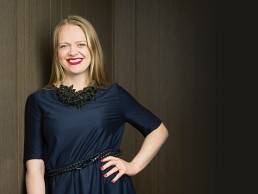
The Emotional Power of Light
Interior designer Jo Littlefair explores the use of light within interiors and how decorative lighting is adopting a more organic aesthetic through sculptural pieces.
“Growing up on a farm in the north-east of England makes the long, dark nights and mornings of the early part of the year feel very familiar. The sense of something cold and mysterious enveloping you can be overwhelming, particularly once the bright lights of Christmas have been packed away, making any glimpses of watery-bright sunshine in the winter sky very welcome. Fire, and the heat and light it gives off, also has a subliminal effect on us all. I believe there is an age-old connection between our emotional state and the presence of a flickering candle to soothe our souls. Like many people, I love the ebb and flow of a fire and the warm light it casts.
My own path into interior design came about by studying textile design as a degree, followed by a long spell of travelling, which concluded with working on a highly-designed ‘super yacht’. This was the first time I’d really seen anything quite so opulent and, whilst it might not have been to my personal taste, it inspired me to pursue a career that allowed me to curate interiors. Three-dimensional structures have always fascinated me too, as well as anything that involved constructing things out of fabrics and threads, paper and metal. If I could bend, burn or sew it, I was hooked!
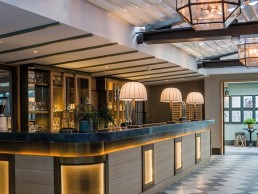
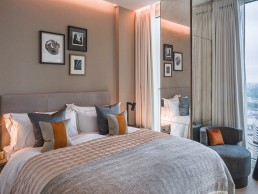
When it came to designing full interior schemes, I immediately recognised the power of light as an essential layer for creating a successful space – adding an accent, highlight or stroke of iridescence that are little short of gifts for an interior designer. Light allows us to make certain elements prominent and knock some things back. It can be functional, but also purely decorative. It is always one of the key things our clients are concerned about – ‘but what about the lighting? – they will ask, which shows how important getting the right light has become and how aware we all are now of its creative, mood-enhancing abilities.
It’s an important and never-ending lesson for designers to discern what makes certain spaces feel welcoming, inspiring or surprising and others cold, hostile and deflating, so that we can design according to how we want people to feel in a space. The trend for lighting the bottom of kitchen islands, so that they look like rockets about to take off baffles me, for example. Blue light is as cold as it gets and so dated already.
People also dislike feeling exposed by light, thanks to glaring lamps and strip lights set within low ceilings. The ability to dim lights and set moods through programmed settings has been of considerable help in our hotel and restaurant work. Programming timers throughout the day to help lighting shift from morning to midday to evening, ideally tailoring the settings for summer and winter too, so that guests don’t feel overwhelmed by harsh lighting in early hours of the morning yet have enough light to navigate the breakfast bar, is a delicately-balanced but powerful creative asset.
Wellness is such a key topic for developers across both the residential and hotel worlds right now, at a time when market places are crowded with brand names and Instagram accounts clamouring for attention. I believe it’s the environment that is relevant and on point, but which ultimately sets you at ease and where your needs are met, that will capitalise on this feeling. Clients are increasingly aware of their own – and their guests’ – dependency on personal technology and there has been much discussion on recent projects about permitting people to disconnect from devices and plug back into the human race. Mental health is thankfully being increasingly recognised as a critical health issue and, as designers, we need to be fully aware of the emotional impact of the spaces we create. Setting out their proposed range of functions and then lighting accordingly plays a crucial part in that.
Technological advances, including intelligent and interactive lighting, as well as the increasing focus on sustainability within the discipline, have also changed our palette of possibility in an entirely positive way, from the ever-diminishing sizes of available fittings to advances in LEDs, although human intelligence still very much needs to be added to the mix, so that they are all handled in a way that doesn’t then create other problems.
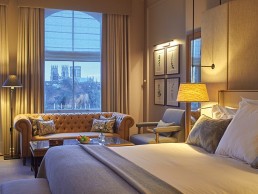
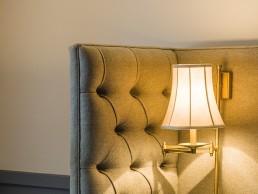
Bowing before new advances simply for the sake of newness is a mistake so often made. For example, we saw the rise in downlights resulting in the overuse of these conveniently-sized fittings. Not only did ceilings look cluttered, but the universal wash of light resulted in interiors without highlights or depth. Spaces often lacked a sense of pace and were simply bland. The effect on the subconscious of overhead lighting is also negative. This type of light is one of the most unflattering and ageing to be seen in, making people feel instantly self-conscious, whilst casting shadows over their faces.
The approach to the lighting of ceilings has to be much more refined – even artistic – concealing fittings where possible so that they wash surfaces and create layering and contrast. If the constraints of a building mean there isn’t adequate height to conceal the fittings, then we make sure instead to create an architectural and bold statement. Sometimes this helps create such a pleasing statement that we do this regardless of the site constraints, such as in the Cluster and Bay show apartments that we designed recently for One Park Drive on Canary Wharf, which won the ‘Residential GOLD Award’ at the 2017 London Design Awards. We created definite slots in the ceiling, which we painted out black, mounting contemporary directional light fittings in them that pick out accents on the walls to wash with light. Highly-textured timber panels on the scheme also conceal built-in storage, designed to echo the exterior façade of the Herzog de Meuron building and the play of this light, and the highlights and shadows it creates, brings out the natural depth of the rich timber, giving the interior the warmth and tactility we sought.
Rafts, hung over a ceiling coffer, are another good way to light ceilings and represent a more contemporary approach to lighting the perimeter of the room. This technique involves dropping a lower section to the centre of the space and adding concealed lighting to the recessed edges of the raft so that it glows, reflects and then washes down the walls. It’s also particularly effective in the corridors of hotels and in entrance halls.
Lighting from the side creates a much more even effect and creates ambience, which can make spaces feel more welcoming and hospitable. Using table and floor lamps to highlight areas of rooms and create light and shade is an incredibly useful tool. The scale and placement of these items is incredibly important. Sometimes, the subtlety of a beautifully-crafted reading lamp that is functional as well as beautiful can add real magic. Or we might create drama and add colour and texture by including a large-scale side lamp. We would always recommend drawing a rough-scale plan and elevation of a table and lamp combination in order to really consider the proportions of pieces. There are general rules when specifying loose lamps, for example, such as matching square lamp bases to square tables and being mindful not to over-scale lampshades so they hang over the edges of tables. There are also times, however when rules are there to be broken, which is why we consider each element in the scheme so carefully!
Recently, we have seen an increase in natural materials trending in decorative lighting. The industrial look, which has been dominant for so long has definitely been superseded by a finer and more elegant approach. Bright, brushed brass juxtaposed against opal glass with marble and timber components often creates an interesting juxtaposition. There is also a more organic aesthetic coming through with sculptural decorative pieces. I feel this has come about as a reaction against the two-dimensional world we swipe and see on our phones day in, day out.
Wherever possible, we try to go back to the theories learnt from those ancient sources of light – candlelight and fires. The presence of nature on my doorstep throughout my childhood was also a huge personal influence and the colours and textures I celebrated with the work I produced in both textile and interior design has always been profoundly important to me. I still hold dear all that nature supplies us with, including the superlative qualities of natural materials such as stone, wood and fibres that have depth, lustre, quality and tactility that seemingly resonate with our very souls – together with lighting that sets them off to perfection.



